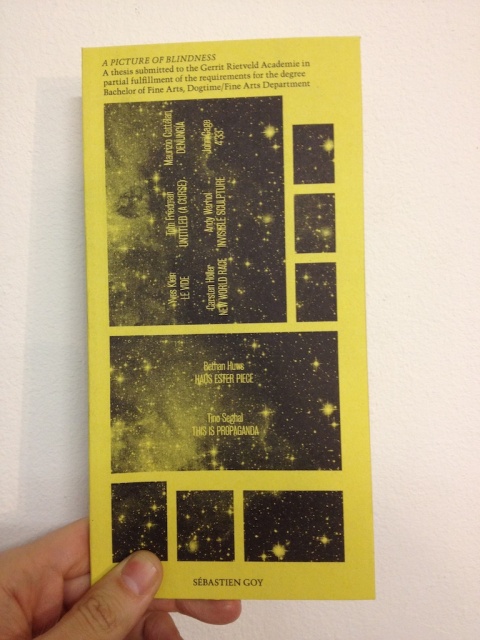A Picture of Blindness
From S E B A S T I E N G O Y
(Created) |
m (typo) |
||
| (8 intermediate revisions not shown) | |||
| Line 1: | Line 1: | ||
| - | + | {{multiple image | |
| + | | footer = '''''A Picture of Blindness'', 2012''' | ||
| + | | footer_align = right | ||
| + | | width = 480 | ||
| + | | image1 = A Picture of Blindness 0.jpg | ||
| + | | alt1 = Cover | ||
| + | }} | ||
| - | <ref>{{cite book |last= Goy |first= Sébastien |title= A Picture of Blindness |publisher= | + | ''Summary'' |
| + | |||
| + | From Yves Klein to Carsten Höller, artists have proposed invisible artworks (Warhol included). What drew these visual artists to non-visibility? Further, is there a collective movement, an “invisibilism”, beyond the artists’ individual context of production? | ||
| + | |||
| + | “A Picture of Blindness”<ref>{{cite book |last= Goy |first= Sébastien |title= A Picture of Blindness |publisher= Éditions En Creux |year= 2012 |month= January |isbn= 978-29541092-0-6|pages=}}</ref> shows that invisible art is unique in its reflexive call upon the Imaginary and the self critique it enables for art. Tom Friedman, for example, exhibited a witch’s curse by presenting an empty pedestal. Mauriozio Cattelan claimed that his work was stolen, showing only a report of theft, as a way to dodge the pressure of art production. Against rationalism, consumerism or representation, turning to invisibility is justified in this essay as one of the few efficient strategies of resistance. | ||
| + | |||
| + | |||
| + | ''Distribution'' | ||
| + | |||
| + | This work is made available under creative commons Attribution-noncommercial- share Alike 3.0 license. You can [[Media: A_Picture_Of_Blindness_—_Sébastien_Goy.pdf |'''download the PDF''']] or buy a copy at: | ||
| + | |||
| + | * [http://www.mottodistribution.com/shop/a-picture-of-blindness.html Motto] online store | ||
| + | * [http://www.castillocorrales.fr/section7/section7.html castillo/corrales] 80 rue Julien Lacroix, 75020 Paris, France | ||
| + | * [http://www.san-serriffe.com/ San Serriffe] Sint Annenstraat 30, 1012 HE, Amsterdam, Netherlands | ||
| + | * [http://www.gerritrietveldacademie.nl/nl/projecten/all/buro-rietveld Buro Rietveld] Gerrit Rietveld Academie, Fred. Roeskestraat 96, 1076ED Amsterdam, The Netherlands | ||
| + | * [http://stroom.nl/ Stroom] Hogewal 1-9, 2514 HA Den Haag, Netherlands | ||
| + | * [http://www.grotewittereus.nl/ Liefhertje en De Grote Witte Reus] Stationsweg 137, 2515 BM Den Haag, Netherlands | ||
| + | * [http://www.colpapress.com/pages/edicola Edicola] 987 1/2 Market St - at 6th St - San Francisco, U.S.A. | ||
| + | |||
| + | |||
| + | ''Bibliographical data'' | ||
<references/> | <references/> | ||
| + | |||
| + | [[Category: Writing]] | ||
Latest revision as of 09:32, 21 January 2014
Summary
From Yves Klein to Carsten Höller, artists have proposed invisible artworks (Warhol included). What drew these visual artists to non-visibility? Further, is there a collective movement, an “invisibilism”, beyond the artists’ individual context of production?
“A Picture of Blindness”[1] shows that invisible art is unique in its reflexive call upon the Imaginary and the self critique it enables for art. Tom Friedman, for example, exhibited a witch’s curse by presenting an empty pedestal. Mauriozio Cattelan claimed that his work was stolen, showing only a report of theft, as a way to dodge the pressure of art production. Against rationalism, consumerism or representation, turning to invisibility is justified in this essay as one of the few efficient strategies of resistance.
Distribution
This work is made available under creative commons Attribution-noncommercial- share Alike 3.0 license. You can download the PDF or buy a copy at:
- Motto online store
- castillo/corrales 80 rue Julien Lacroix, 75020 Paris, France
- San Serriffe Sint Annenstraat 30, 1012 HE, Amsterdam, Netherlands
- Buro Rietveld Gerrit Rietveld Academie, Fred. Roeskestraat 96, 1076ED Amsterdam, The Netherlands
- Stroom Hogewal 1-9, 2514 HA Den Haag, Netherlands
- Liefhertje en De Grote Witte Reus Stationsweg 137, 2515 BM Den Haag, Netherlands
- Edicola 987 1/2 Market St - at 6th St - San Francisco, U.S.A.
Bibliographical data
- ↑ Goy, Sébastien (January 2012). A Picture of Blindness. Éditions En Creux. ISBN 978-29541092-0-6.
